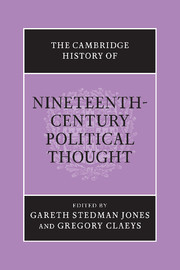Book contents
- Frontmatter
- Contents
- Contributors
- Acknowledgements
- Introduction
- I Political thought after the French Revolution
- II Modern liberty and its defenders
- III Modern liberty and its critics
- IV Secularity, reform and modernity
- 18 Church and state: the problem of authority
- 19 The politics of nature
- 20 Conservative political thought from the revolutions of 1848 until the fin de siècle
- 21 Modern liberty redefined
- 22 Political economy
- 23 German socialism and social democracy 1860 –1900
- 24 Russian political thought of the nineteenth century
- 25 European political thought and the wider world during the nineteenth century
- 26 Empire and imperialism
- Epilogue
- Biographies
- Bibliography
- Index
20 - Conservative political thought from the revolutions of 1848 until the fin de siècle
from IV - Secularity, reform and modernity
Published online by Cambridge University Press: 28 July 2011
- Frontmatter
- Contents
- Contributors
- Acknowledgements
- Introduction
- I Political thought after the French Revolution
- II Modern liberty and its defenders
- III Modern liberty and its critics
- IV Secularity, reform and modernity
- 18 Church and state: the problem of authority
- 19 The politics of nature
- 20 Conservative political thought from the revolutions of 1848 until the fin de siècle
- 21 Modern liberty redefined
- 22 Political economy
- 23 German socialism and social democracy 1860 –1900
- 24 Russian political thought of the nineteenth century
- 25 European political thought and the wider world during the nineteenth century
- 26 Empire and imperialism
- Epilogue
- Biographies
- Bibliography
- Index
Summary
The emergence and definition of the conservative tradition
Like so much of the vocabulary of modern politics and social science, the term ‘conservative’ can be traced back to the early nineteenth century (Vierhaus 1973, i, pp. 477–85). Its first use was apparently in the title of the weekly journal founded in 1817 by Francois René de Chateaubriand (1768–1848) and Louis de Bonald (1754–1840), Le Conservateur. Its declared mission was to uphold ‘religion, the King, liberty, the Charter and respectable people [les honnêtes gens]’. In Britain the term was first used as a synonym for the Tory Party in 1830. It rapidly became a part of the vocabulary of politics during the Reform Bill crisis of 1831–2. Daniel O'Connell, the political leader of Irish Catholicism, noted the new coinage in 1832: ‘Conservative – that is the fashionable term, the new-fangled phrase now used in Polite Society to designate the Tory ascendancy.’ It was being used pejoratively against conservatives in Germany by the late 1830s, but there, as elsewhere, the political formations opposed to change came to accept and employ the term themselves. By the middle of the nineteenth century the term was in universal use and it is the purpose of this essay to explain the different ideological positions, groups and individuals who were embraced by it. The essay will consider the different conservative reactions to the mid-century European revolutions and the emergence of mass politics. It will also examine the ways in which conservatism changed over time from the anti-revolutionary creed of 1848 to the more complex, intellectualised and yet irrational forms it had adopted by the end of the century. Because there was no single, dominant conservative thinker in this period the essay will examine different variants of the creed from the United States to the Russian Empire – from the South Carolina of John C. Calhoun to the St Petersburg of Dostoevsky. And because it will be argued that conservatism was more a set of attitudes generated by specific historical situations than a systematic ideology, the treatment will closely relate conservative thought to the history of the era.
- Type
- Chapter
- Information
- The Cambridge History of Nineteenth-Century Political Thought , pp. 691 - 719Publisher: Cambridge University PressPrint publication year: 2011
- 1
- Cited by



